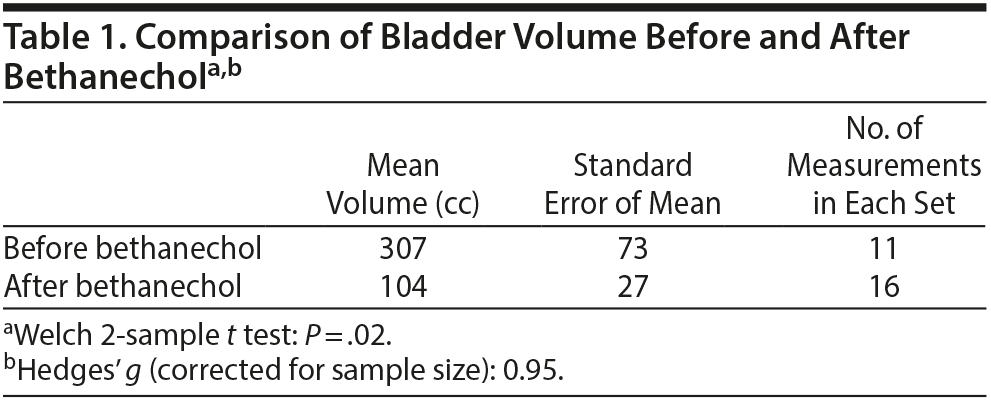Because this piece does not have an abstract, we have provided for your benefit the first 3 sentences of the full text.
Bethanechol, a long-acting muscarinic agonist, has been successfully used as a corrective for bowel dysmotility associated with clozapine. Although bethanechol is indicated as a treatment for urinary retention, several reports in the literature have questioned its effectiveness. We report a case in which bethanechol clearly improved urinary retention as an adverse effect of olanzapine.

This work may not be copied, distributed, displayed, published, reproduced, transmitted, modified, posted, sold, licensed, or used for commercial purposes. By downloading this file, you are agreeing to the publisher’s Terms & Conditions.
Bethanechol as a Corrective for Urinary Retention Associated With Olanzapine Administration
Bethanechol, a long-acting muscarinic agonist, has been successfully used as a corrective for bowel dysmotility associated with clozapine.1 Although bethanechol is indicated as a treatment for urinary retention, several reports2,3 in the literature have questioned its effectiveness. We report a case in which bethanechol clearly improved urinary retention as an adverse effect of olanzapine.
Case Report
A 66-year-old man with posttraumatic stress disorder and dementia was taken by his family to the emergency department because of assaultive behavior at home. His cognitive decline became symptomatic around age 58 years, at which time he had to retire from his job as a police officer. He boxed competitively as a young man, and traumatic encephalopathy may have contributed to his dementia. The patient’s father died of Alzheimer’s disease at age 68 years. The patient was admitted to our geriatric psychiatry unit due to persistent behavioral disturbances. Neuropsychological testing included the Montreal Cognitive Assessment,4 Geriatric Depression Scale,5 and Geriatric Anxiety Inventory6 and resulted in scores of 3/30, 7/15, and 7/20, respectively. His outpatient medication regimen consisted of galantamine 8 mg daily and sertraline 100 mg daily. While in our unit, the patient exhibited nearly continuous anxiety, which periodically escalated to paranoia (accused the examining clinician of attempted rape) leading to violent outbursts (throwing objects at staff). At admission, sertraline was increased to 150 mg, mirtazapine 7.5 mg was added to improve sleep, and galantamine was discontinued as it was ineffective. The violent outbursts persisted, and olanzapine 2.5 mg was administered intramuscularly as needed. This last intervention proved effective, and olanzapine 5 mg orally twice per day was scheduled. During this period of attempts to control his violent outbursts, the patient developed urinary retention, which periodically required catheterization. A urologist had examined the patient by cystoscopy within the preceding year and found no significant anatomic lesions. Therefore, we attributed retention to the anticholinergic burden of his behavioral drug regimen. Monitoring bladder scans were ordered 3 times a day; these were not performed to measure post-void residual volumes but rather as random screens. Mirtazapine was discontinued with no improvement of retention; terazosin and finasteride were started but had no effect. Bethanechol was initiated at 30 mg daily in divided doses. Over several days, the dose was titrated up to 50 mg daily. This regimen (three 10-mg daytime doses and one 20-mg bedtime dose) led to complete resolution of urinary retention.
Discussion
Table 1 summarizes the measurements of bladder volumes before and after the addition of bethanechol to the regimen. The "before" period refers to the time after mirtazapine had been discontinued but prior to any dose of bethanechol. The "after" period starts with the day that bethanechol titration reached its final dose. During both periods, the olanzapine dose was 10 mg daily in divided doses, with occasional additional doses given as needed. There was a statistically significant decrease in the measured bladder volumes (P < .05), and Hedges’ g factor indicates a large effect (g > 0.8). Clinically, the patient required no further catheterization. Although significant, these statistics do not imply that this result will generalize to other patients.
Olanzapine has been associated with urinary retention,7,8 resulting in the need to alter therapy. In this case, the urgency of controlling the patient’s outbursts prompted the search for another strategy. In the urological literature, the skepticism about the therapeutic effectiveness of bethanechol stems from its use in the treatment of spinal cord injuries or postsurgical urinary retention.9 Its possible use as a corrective for the anticholinergic burden of psychiatric regimens is not discussed in the urologic literature. The present case demonstrates its potential utility in ameliorating anticholinergic side effects, in particular, urinary retention.
Published online: October 31, 2019.
Potential conflicts of interest: None.
Funding/support: This work was supported by the Department of Veterans Affairs.
Role of the sponsor: The Department of Veterans Affairs established the clinical unit in which this patient was cared for but had no other role in this work.
Disclaimer: Any opinions are those of the authors alone.
Additional information: Information has been de-identified to protect anonymity.
REFERENCES
1.Poetter CE, Stewart JT. Treatment of clozapine-induced constipation with bethanechol. J Clin Psychopharmacol. 2013;33(5):713-714. PubMed CrossRef
2.Downie JW. Bethanechol chloride in urology: a discussion of issues. Neurourol Urodyn. 1984;3(4):211-222. CrossRef
3.Taylor JA 3rd, Kuchel GA. Detrusor underactivity: clinical features and pathogenesis of an underdiagnosed geriatric condition. J Am Geriatr Soc. 2006;54(12):1920-1932. PubMed CrossRef
4.Nasreddine ZS, Phillips NA, Bédirian V, et al. The Montreal Cognitive Assessment, MoCA: a brief screening tool for mild cognitive impairment. J Am Geriatr Soc. 2005;53(4):695-699. PubMed
5.Yesavage JA, Brink TL, Rose TL, et al. Development and validation of a geriatric depression screening scale: a preliminary report. J Psychiatr Res. 1982-1983-1983;17(1):37-49. PubMed CrossRef
6.Pachana NA, Byrne GJ, Siddle H, et al. Development and validation of the Geriatric Anxiety Inventory. Int Psychogeriatr. 2007;19(1):103-114. PubMed
7.Semaan WE, Doyon J, Jolicoeur F, et al. Dose-dependent urinary retention following olanzapine administration. Ann Pharmacother. 2006;40(9):1693. PubMed CrossRef
8.Cohen R, Wilkins KM, Ostroff R, et al. Olanzapine and acute urinary retention in two geriatric patients. Am J Geriatr Pharmacother. 2007;5(3):241-246. PubMed CrossRef
9.Finkbeiner AE. Is bethanechol chloride clinically effective in promoting bladder emptying? a literature review. J Urol. 1985;134(3):443-449. PubMed CrossRef
aGeriatric Psychiatry Unit, Edith Nourse Rogers Memorial Veterans Hospital, Bedford, Massachusetts
*Corresponding author: Frank A. Greco, MD, PhD, Geriatric Psychiatry Unit (151B), Edith Nourse Rogers Memorial Veterans Hospital, Bedford, MA 01730 ([email protected]).
Prim Care Companion CNS Disord 2019;21(5):19l02429
To cite: Greco FA, Simms NJ, Athappilly GK. Bethanechol as a corrective for urinary retention associated with olanzapine administration. Prim Care Companion CNS Disord. 2019;21(5):19l02429.
To share: https://doi.org/10.4088/PCC.19l02429
© Copyright 2019 Physicians Postgraduate Press, Inc.
Please sign in or purchase this PDF for $40.00.
Save
Cite




